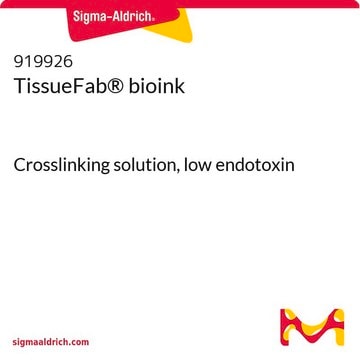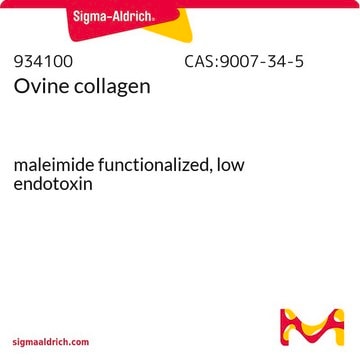934119
Ovine collagen
SPDP functionalized, low endotoxin
Sinónimos:
CollOvine™-SPDP
Iniciar sesiónpara Ver la Fijación de precios por contrato y de la organización
About This Item
Productos recomendados
Quality Level
form
lyophilized
impurities
Bioburden, none detected
≤0.1 EU/mg Endotoxin
color
white to off-white
functional group
SPDP
¿Está buscando productos similares? Visita Guía de comparación de productos
Categorías relacionadas
General description
Collagen is a major component of the extracellular matrix (ECM) and offers low immunogenicity, a porous structure, good permeability, and biocompatibility to promote cell viability, adhesion, spreading, proliferation and differentiation.
Low endotoxin SPDP functionalized collagen derived from ovine can be used for the covalent conjugation with sulfhydryl-containing molecules. The primary amine groups (lysine residues) of the collagen are reacted with succinimidyl 3-(2-pyridyldithio)propionate (SPDP) to yield collagen derived with a cleavable disulfide bond. The cleaved linker can react with other species containing containing free sulhydryl groups (i.e. cysteine residues) which are commonly found in many naturally occurring protein or peptide sequences.
Low endotoxin SPDP functionalized collagen derived from ovine can be used for the covalent conjugation with sulfhydryl-containing molecules. The primary amine groups (lysine residues) of the collagen are reacted with succinimidyl 3-(2-pyridyldithio)propionate (SPDP) to yield collagen derived with a cleavable disulfide bond. The cleaved linker can react with other species containing containing free sulhydryl groups (i.e. cysteine residues) which are commonly found in many naturally occurring protein or peptide sequences.
Application
- 3D bioprinting
- Tissue engineering
- Drug delivery
- Regenerative medicine
- Cell culture, encapsulation, expansion and differentiation
Features and Benefits
- Certified Disease Free Sheep
- 93-97% Type I Collagen
- 3-7% Type III Collagen
- 99% Purity
- Prion Free
Legal Information
CollOvine is a trademark of OviGenex LLC
related product
Referencia del producto
Descripción
Precios
Storage Class
11 - Combustible Solids
wgk_germany
WGK 1
flash_point_f
Not applicable
flash_point_c
Not applicable
Certificados de análisis (COA)
Busque Certificados de análisis (COA) introduciendo el número de lote del producto. Los números de lote se encuentran en la etiqueta del producto después de las palabras «Lot» o «Batch»
¿Ya tiene este producto?
Encuentre la documentación para los productos que ha comprado recientemente en la Biblioteca de documentos.
Egor Olegovich Osidak et al.
International journal of bioprinting, 6(3), 270-270 (2020-10-23)
Biomaterials made using collagen are successfully used as a three-dimensional (3D) substrate for cell culture and considered to be promising scaffolds for creating artificial tissues. An important task that arises for engineering such materials is the simulation of physical and
Collagen as Bioink for Bioprinting: A Comprehensive Review
Osidak E O, et al.
International Journal of Bioprinting, 6(3), 270-270 (2020)
Elizabeth E Antoine et al.
Tissue engineering. Part B, Reviews, 20(6), 683-696 (2014-06-14)
Type I collagen hydrogels have been used successfully as three-dimensional substrates for cell culture and have shown promise as scaffolds for engineered tissues and tumors. A critical step in the development of collagen hydrogels as viable tissue mimics is quantitative
Jana Stepanovska et al.
Biomedicines, 9(9), 1137-1137 (2021-09-29)
Bioprinting is a modern tool suitable for creating cell scaffolds and tissue or organ carriers from polymers that mimic tissue properties and create a natural environment for cell development. A wide range of polymers, both natural and synthetic, are used
Atiqah Salleh et al.
Biomedicines, 10(4), 816-816 (2022-04-24)
Tissue engineering products have grown rapidly as an alternative solution available for chronic wound and burn treatment. However, some drawbacks include additional procedures and a lack of antibacterial properties that can impair wound healing, which are issues that need to
Nuestro equipo de científicos tiene experiencia en todas las áreas de investigación: Ciencias de la vida, Ciencia de los materiales, Síntesis química, Cromatografía, Analítica y muchas otras.
Póngase en contacto con el Servicio técnico






